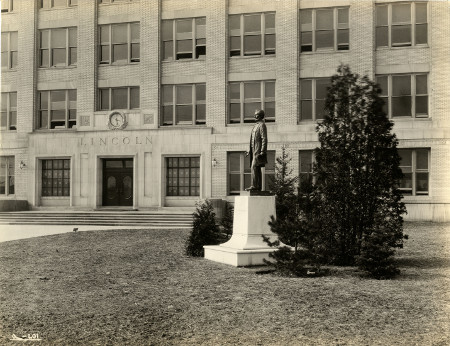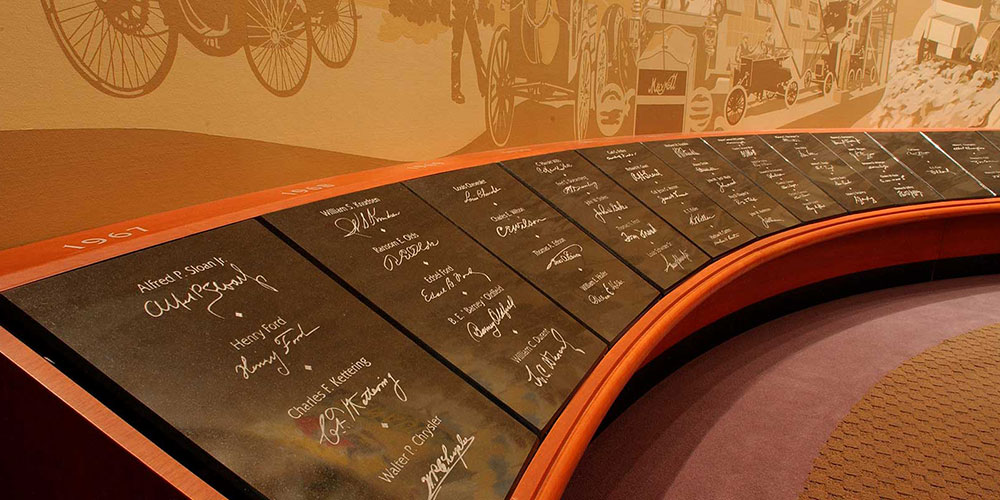By Robert Tate, Automotive Historian and Researcher
Images courtesy of the National Automotive History Collection
Posted: 06.06.2016
 Statue of Abraham Lincoln taken in 1920 in front of the Lincoln Motor Company headquarters
Statue of Abraham Lincoln taken in 1920 in front of the Lincoln Motor Company headquarters
The history regarding the Lincoln Motor Car Co. begins with the years 1917-19, when the late Henry Leland began to manufacture Lincoln automobiles at the Liberty aircraft plant where aircraft engines were manufactured for World War I.
Leland had a great passion and reputation as a machinist along with being a significant contributor to the auto industry. Mr. Leland had become very popular within the automotive community and with many other industrial companies as well. During his early years, Leland created a great success story with Oldsmobile and Cadillac along with the introduction of the self-starter and the V8 engine.
The first Lincoln model L automobile was manufactured on Sept. 14, 1920 and at that time the company had announced plans to manufacture eight body styles for the consumer market. The Lincoln name plate comes from Leland's life-time hero, Abraham Lincoln.

Lincoln saw much success in the early years of the company’s existence. Some buyers even ordered the new Lincoln automobiles sight unseen. This was a great time in our American automotive culture, as the Lincoln automobile was beginning to take shape and create its own chapter within the automotive industry.
Financial problems, however, were beginning to take place within the company and customers were starting to complain about Lincoln’s styling features, some describe the models as “Characteristic Straight Line.” Consistent production delays and the post-war recession in America also took its toll on the burgeoning car company.

Seeing an opportunity, Henry Ford purchased the company from Leland on Feb.4, 1922. Those present during the completion of this historic automotive sale included Henry Ford along with his son, Edsel, and Henry M. Leland, president, and his son, Wilfred Leland, who was vice president of Lincoln at the time.
Henry Ford had purchased the company for $8 million. Gone was the horseless carriage days, as the American auto industries and manufacturing processes had changed. As for Ford, they were now manufacturing the great and new Lincoln automobiles, the Lincoln name plate was becoming one of the most respected names in the automotive market.
Establishing a new direction for the Lincoln brand was a task given to Henry’s only child, Edsel who had been incorporating news concepts for marketing and styling. This would change Lincoln's new look for the future.

It should also be noted that it was the men and women working on the assembly line who did a well skilled and great performance job of manufacturing the Lincoln automobiles for the consumer market. Because of the great craftsmanship behind the Lincoln car, sales of the brand would continue to grow in Ford's favor.
On Jan. 19, 1922, Henry Ford said “To build a car as nearly perfect as humanly possible,” and this became the standard process and concept for manufacturing Lincoln automobiles with great pride and quality workmanship. During the early days of assembly, some workers were called “Wood Workers” because of the wood material that they used in the process of manufacturing the Lincoln automobile.
The second Lincoln factory plant was located at 6200 W. Warren Avenue in Detroit, Michigan. In 1978, the factory was designated as a National Historic Landmark because of its great historic contribution with World War I and Liberty engines and the Lincoln Motor Car Company.

The facility had offered its assembly workers 600,000 square feet of room for manufacturing Lincoln automobiles. The plant offered many areas of production such as the inspection room, gear inspection along with the dimensional control center and many other areas of production locations.
In the early 1950s, Lincoln manufacturing would move to the Wixom assembly plant. In 1955, the Detroit Edison Co. purchased the facilities for $4,500,000. Unfortunately, in 2002-03, most of the historic buildings were demolished. Today, the buildings are no longer with Detroit's historic past however Lincoln’s heritage will always be a part of our automotive history.

A special thanks to Robert Tate, Automotive Historian and Researcher, for contributing this story to the MotorCities Story of the Week Program.
For further information on photos please visit http://www.detroitpubliclibrary.org/ or email This email address is being protected from spambots. You need JavaScript enabled to view it.. Please do not republish the story and/or photographs without permission of MotorCities National Heritage Area. (Bibliography: McCall M .P. Walter. “80 Years of Cadillac La Salle” Crestline Publishing Co 1988; Holls Dave & Lamm Michael. “A Century of Automotive Style 100 years of American car design”. Lamm-Morada publishing 1996-1997; Kimes Rae Beverly & Jr. Clark Austin Henry. “Standard Catalog of American cars 1805-1942”. Krause publication 1987.)



